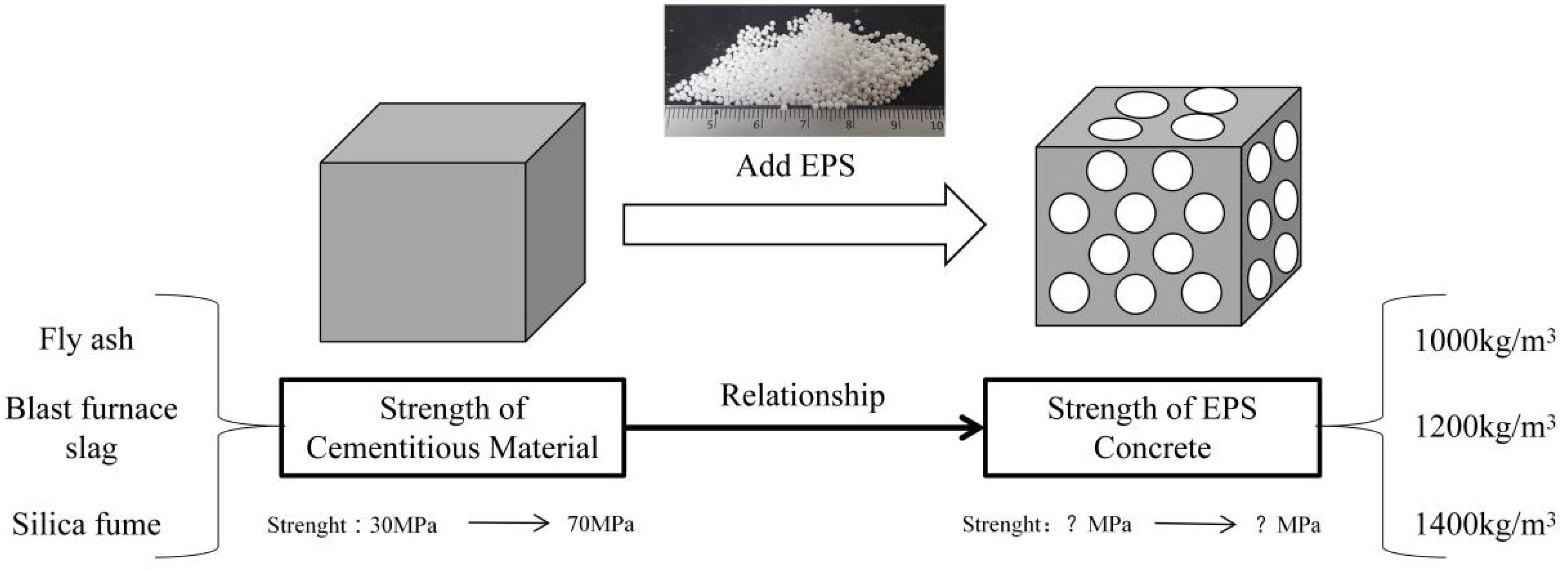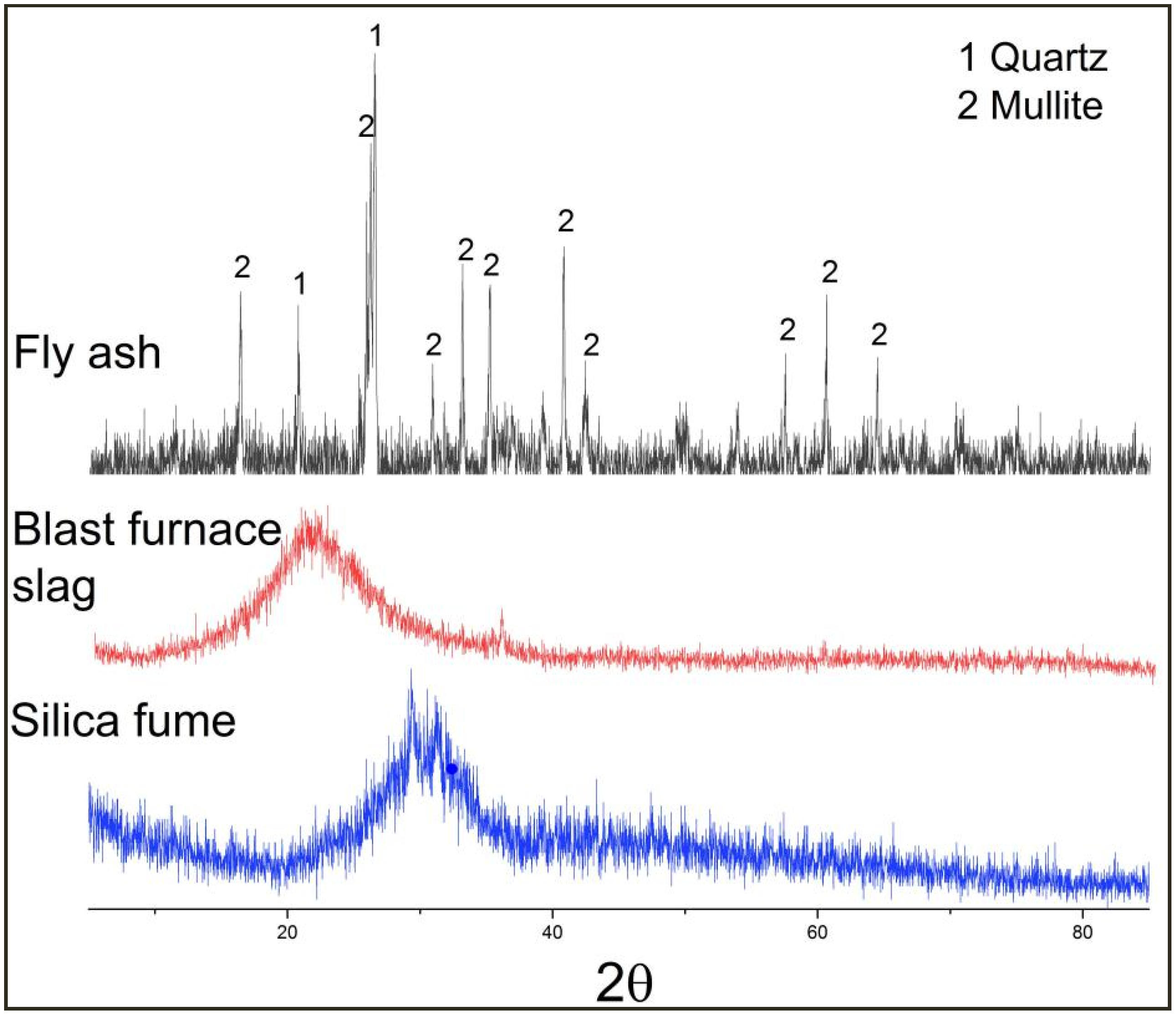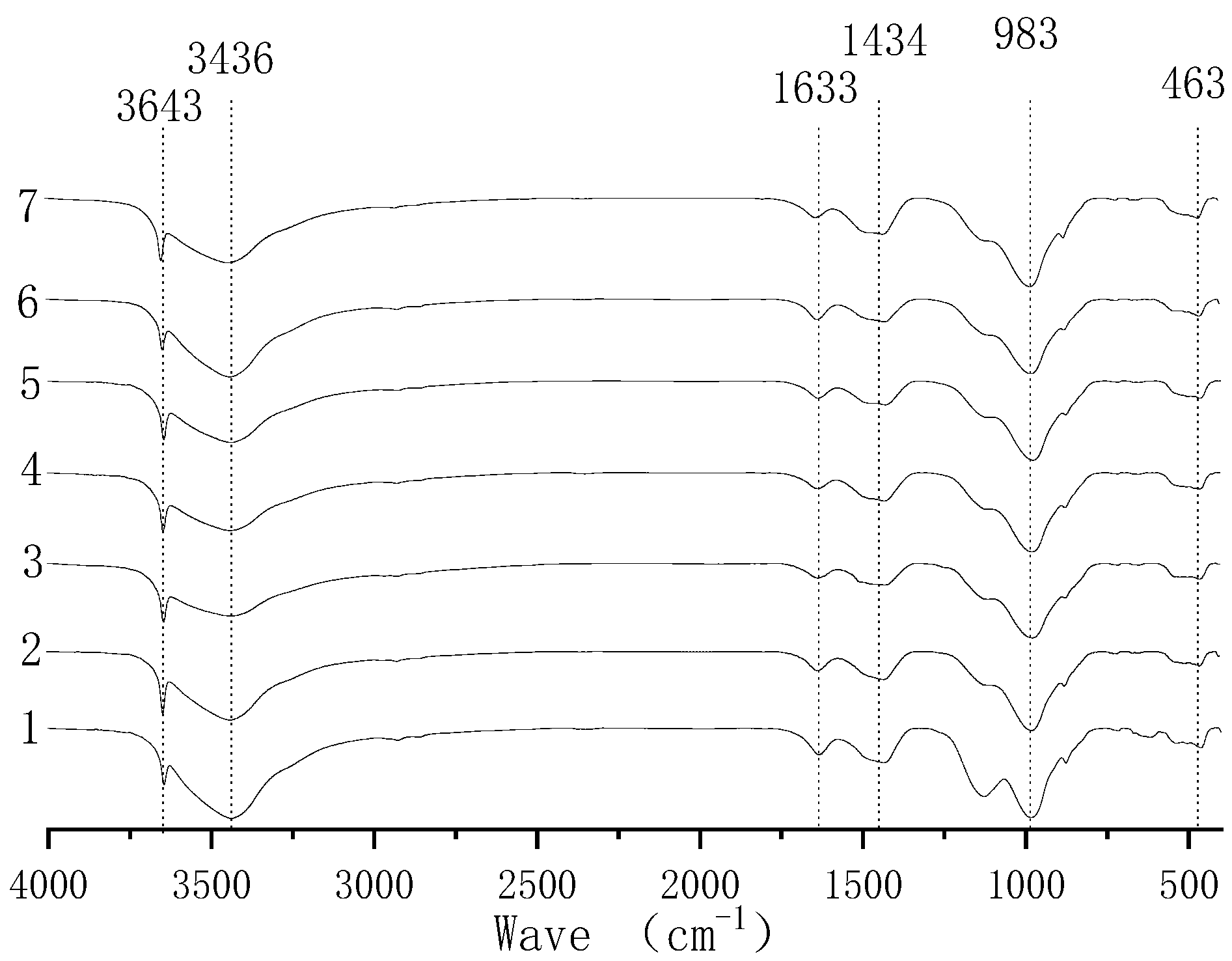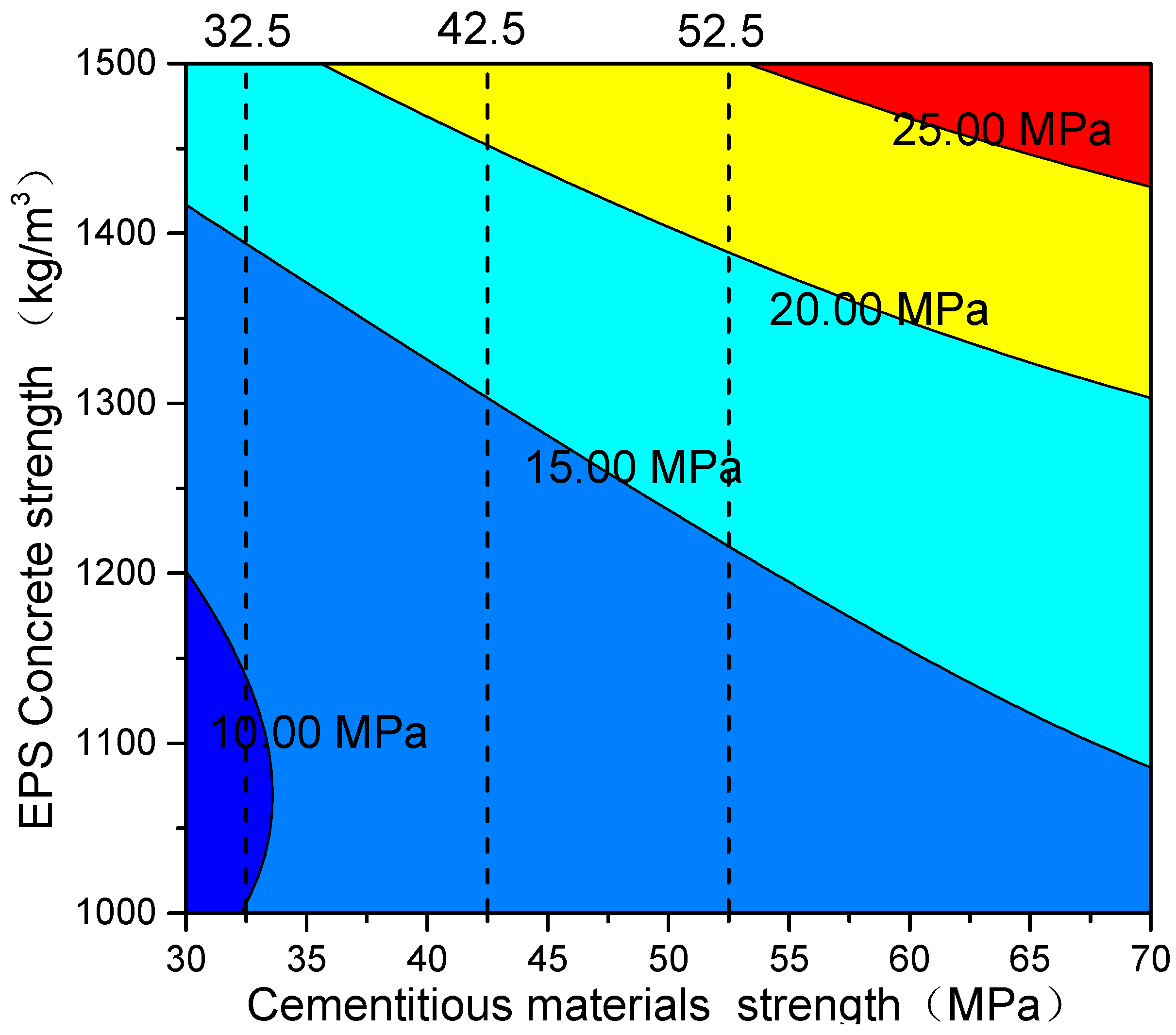Influence of Paste Strength on the Strength of Expanded Polystyrene (EPS) Concrete with Different Densities
Abstract
:1. Introduction
2. Materials and Methods
2.1. Raw Materials
2.2. Experimental Method and Mix Proportion Design
2.3. Experimental Process and Test Method
3. Result and Discussion
4. Conclusions
Author Contributions
Funding
Institutional Review Board Statement
Informed Consent Statement
Data Availability Statement
Acknowledgments
Conflicts of Interest
References
- Yang, J.; Cai, W.; Ma, M.; Li, L.; Liu, C.; Ma, X.; Li, L.; Chen, X. Driving forces of China’s CO2 emissions from energy consumption based on Kaya-LMDI methods. Sci. Total Environ. 2020, 711, 134569. [Google Scholar] [CrossRef] [PubMed]
- International Energy Agency. Key World Energy Statistics; IEA: Paris, France, 2017. [Google Scholar]
- Chuqing, D. Study on the Compounding and Performance on EPS Thermal. Master’s Thesis, Shanghai Jiao Tong University, Shanghai, China, 2010. [Google Scholar]
- Zhao, J.; Tong, L.; Li, B.; Chen, T.; Wang, C.; Yang, G.; Zheng, Y. Eco-friendly geopolymer materials: A review of performance improvement, potential application and sustainability assessment. J. Clean. Prod. 2021, 307, 127085. [Google Scholar] [CrossRef]
- Liu, N.; Chen, B. Experimental study of the influence of EPS particle size on the mechanical properties of EPS lightweight concrete. Constr. Build. Mater. 2014, 68, 227–232. [Google Scholar] [CrossRef]
- Mehta, P.K.; Monteiro, J.M. Concrete: Structure, Properties, and Materials; Brentice-Hall: Hoboken, NJ, USA, 1986. [Google Scholar]
- Beltrán, M.G.; Barbudo, A.; Agrela, F.; Galvín, A.P.; Jiménez, J.R. Effect of cement addition on the properties of recycled concretes to reach control concretes strengths. J. Clean. Prod. 2014, 79, 124–133. [Google Scholar] [CrossRef]
- Khatib, J.; Herki, B.; Elkordi, A. Characteristics of concrete containing EPS. In Use of Recycled Plastics in Eco-Efficient Concrete; Woodhead Publishing: Thorston, UK, 2019; pp. 137–165. [Google Scholar]
- Chen, W.; Hao, H.; Hughes, D.; Shi, Y.; Cui, J.; Li, Z.-X. Static and dynamic mechanical properties of expanded polystyrene. Mater. Design. 2015, 69, 170–180. [Google Scholar] [CrossRef]
- Zou, W.-L.; Wan, L.-L.; Han, Z.; Wang, X.-Q. Effect of stress history on compressive and rheological behaviors of EPS geofoam. Constr. Build. Mater. 2019, 228, 116592. [Google Scholar] [CrossRef]
- Congmi, C. Research on the Performance Influenced by Composition and Structural of EPS Lightweight Aggregate Concrete. Ph.D. Thesis, South China University of Technology, Guangzhou, China, 2013. [Google Scholar]
- Maghfouri, M.; Alimohammadi, V.; Gupta, R.; Saberian, M.; Azarsa, P.; Hashemi, M.; Asadi, I.; Roychand, R. Drying shrinkage properties of expanded polystyrene (EPS) lightweight aggregate concrete: A review. Case Stud. Constr. Mater. 2022, 16, e00919. [Google Scholar] [CrossRef]
- Kumar, C.V.; Arun, E.; Bhaskar, B. Light Weight Concrete Using EPS (Expanded Polystyrene) Beads. Available online: www.ijrpr.com (accessed on 17 January 2022).
- Gu, L.; Ozbakkaloglu, T. Use of recycled plastics in concrete: A critical review. Waste Manag. 2016, 51, 19–42. [Google Scholar] [CrossRef]
- Zhang, W.; Lyu, Y.; Liu, P. Review on the research progress of EPS concrete. Mater. Rep. 2019, 33, 2214–2228. [Google Scholar]
- Sulong, N.H.R.; Mustapa, S.A.S.; Abdul Rashid, M.K. Application of expanded polystyrene (EPS) in buildings and constructions: A review. J. Appl. Polym. Sci. 2019, 136, 47529. [Google Scholar] [CrossRef] [Green Version]
- Xiaoli, C. The Study of the Lightweight Concrete Block’s Mechanism of Action with Admixture’s Modified. Master’s Thesis, Guangxi University of Science and Technology, Liuzhou, China, 2013. [Google Scholar]
- Jie, P. Development of Engry-Saving Lightweight Polystyrene Concrete Block. Master’s Thesis, Guangxi University of Science and Technology, Liuzhou, China, 2013. [Google Scholar]
- Xuemei, R. Experimental Study on the Influence of Silica Fume to Static and dynamic Mechanical Properties of EPS Concrere. Master’s Thesis, Anhui University of Science and Technology, Huainan, China, 2016. [Google Scholar]
- Yuanchun, L. Study on Experiment and Constitutive Model of EPS Concrete and Energy-Saving Evaluation. Ph.D. Thesis, China Earthquake Adminsistration, Wuhan, China, 2013. [Google Scholar]
- Lei, G. Study on Energy Absorption Characteristics and frost Resistance of Foam Concrete and EPS Concrete. Ph.D. Thesis, Northeast Forestry University, Harbin, China, 2019. [Google Scholar]
- Liu, Y.C.; Hou, W.J.; Wang, H.T. An experimental analysis of reinforced mechanism of polypropylene fiber reinforced EPS concrete. In Advanced Materials Research; Trans Tech Publications Ltd.: Brussels, Switzerland, 2012; pp. 463–466. [Google Scholar]
- Li, L.; Qin, D.; Xu, Z.; Feng, Y. Study on Strengthening Mechanism of Epoxy Resin/Rubber Concrete Interface by Molecular Dynamics Simulation. Adv. Civ. Eng. 2022, 2022, 5100758. [Google Scholar] [CrossRef]
- Meihong, X. Thermally Modified EPS Material and Its Lightweight Concrete Physical Mechanical Properties. Master’s Thesis, Southwest University of Science and Technology, Mianyang, China, 2020. [Google Scholar]
- Zhao, X.Y.; Tian, W.L.; Jiang, X.L.; Zhou, M.J. Properties and microstructures of EPS lightweight concrete modified with EVA. J. Build. Mater. 2010, 13, 243–246. [Google Scholar]
- Ly, H.-B.; Nguyen, T.-A.; Tran, V.Q. Development of deep neural network model to predict the compressive strength of rubber concrete. Constr. Build. Mater. 2021, 301, 124081. [Google Scholar] [CrossRef]
- Shahmansouri, A.A.; Yazdani, M.; Ghanbari, S.; Bengar, H.A.; Jafari, A.; Ghatte, H.F. Artificial neural network model to predict the compressive strength of eco-friendly geopolymer concrete incorporating silica fume and natural zeolite. J. Clean. Prod. 2021, 279, 123697. [Google Scholar] [CrossRef]
- Feng, Y.; Qin, D.; Li, L.; Li, Y.; Wang, C.; Wang, P. EVA enhances the interfacial strength of EPS concrete: A molecular dynamics study. J. Exp. Nanosci. 2021, 16, 382–396. [Google Scholar] [CrossRef]
- Yuan, X.; Tian, Y.; Ahmad, W.; Ahmad, A.; Usanova, K.I.; Mohamed, A.M.; Khallaf, R. Machine Learning Prediction Models to Evaluate the Strength of Recycled Aggregate Concrete. Materials 2022, 15, 2823. [Google Scholar] [CrossRef]
- Sadrmomtazi, A.; Sobhani, J.; Mirgozar, M. Modeling compressive strength of EPS lightweight concrete using regression, neural network and ANFIS. Constr. Build. Mater. 2013, 42, 205–216. [Google Scholar] [CrossRef]
- Nguyen, T.; Ghazlan, A.; Nguyen, T.; Thai, H.-T.; Ngo, T. Uncertainty quantification of the mechanical properties of lightweight concrete using micromechanical modelling. Int. J. Mech. Sci. 2020, 173, 105468. [Google Scholar] [CrossRef]
- Kang, J. Finite element analysis for deeply buried concrete pipes in proposed imperfect trench installations with expanded polystyrene (EPS) foams. Eng. Struct. 2019, 189, 286–295. [Google Scholar] [CrossRef]
- Akis, E.; Guven, G.; Lotfisadigh, B. Predictive models for mechanical properties of expanded polystyrene (EPS) geofoam using regression analysis and artificial neural networks. Neural Comput. Appl. 2022. [Google Scholar] [CrossRef]
- Hamah Sor, N.; Hilal, N.; Faraj, R.H.; Ahmed, H.U.; Sherwani, A.F.H. Experimental and empirical evaluation of strength for sustainable lightweight self-compacting concrete by recycling high volume of industrial waste materials. Eur. J. Environ. Civ. Eng. 2021, 1–18. [Google Scholar] [CrossRef]
- Zamora-Castro, S.A.; Salgado-Estrada, R.; Sandoval-Herazo, L.C.; Melendez-Armenta, R.A.; Manzano-Huerta, E.; Yelmi-Carrillo, E.; Herrera-May, A.L. Sustainable development of concrete through aggregates and innovative materials: A review. Appl. Sci. 2021, 11, 629. [Google Scholar] [CrossRef]
- Gutierrez-Velasquez, E.I.; Monteiro, S.N.; Colorado, H.A. Characterization of expanded polystyrene waste as binder and coating material. Case Stud. Constr. Mater. 2022, 16, e00804. [Google Scholar] [CrossRef]
- Da Silva, T.R.; de Azevedo, A.R.G.; Cecchin, D.; Marvila, M.T.; Amran, M.; Fediuk, R.; Vatin, N.; Karelina, M.; Klyuev, S.; Szelag, M. Application of plastic wastes in construction materials: A review using the concept of life-cycle assessment in the context of recent research for future perspectives. Materials 2021, 14, 3549. [Google Scholar] [CrossRef] [PubMed]
- Zhu, H.; Li, H.; Ma, X.; Wu, F.; Zhou, Q.; Bai, Y. Combined effect of coal chemical wastewater and PC on preparing of coal-to-liquids residue-based alkali activated materials. J. Hazard. Mater. 2021, 405, 124229. [Google Scholar] [CrossRef] [PubMed]
- Zhu, H.; Qiao, P.; Zhang, Y.; Chen, J.; Li, H. Efflorescence of microwave-heated alkali-activated cement synthesized with ultrafine coal combustion ashes. Fuel 2021, 303, 121225. [Google Scholar] [CrossRef]
- JC/T 2458-2018; Polystyrene Granule Foamed Concrete. Technical Supervision & Research Center for China Building Materials Industry: Beijing, China, 2018.
- De Larrard, F. Concrete Mixture Proportioning: A Scientific Approach; CRC Press: Boca Raton, FL, USA, 1999. [Google Scholar]
- Yang, C.-C.; Huang, R. A two-phase model for predicting the compressive strength of concrete. Cem. Concr. Res. 1996, 26, 1567–1577. [Google Scholar] [CrossRef]
- Beaudoin, J.; Feldman, R.; Tumidajski, P. Pore structure of hardened Portland cement pastes and its influence on properties. Adv. Cem. Based Mater. 1994, 1, 224–236. [Google Scholar] [CrossRef]
- Zhu, L.; Zhou, J.; Lv, M.; Yu, H.; Zhao, H.; Xu, X. Specific component comparison of extracellular polymeric substances (EPS) in flocs and granular sludge using EEM and SDS-PAGE. Chemosphere 2015, 121, 26–32. [Google Scholar] [CrossRef]
- Chang, C.-F.; Chen, J.-W. The experimental investigation of concrete carbonation depth. Cem. Concr. Res. 2006, 36, 1760–1767. [Google Scholar] [CrossRef]
- Babu, D.S.; Babu, K.G.; Tiong-Huan, W. Effect of polystyrene aggregate size on strength and moisture migration characteristics of lightweight concrete. Cem. Concr. Compos. 2006, 28, 520–527. [Google Scholar] [CrossRef]
- Luo, X.; Si, Y.; Gu, W. Effect of Silica Fume on Mechanical Properties of Concrete Incorporating Steel Slag Powder. Wuhan Univ. J. Nat. Sci. 2019, 24, 86–92. [Google Scholar] [CrossRef]







| Chemical Composition (wt.%) | SiO2 | Al2O3 | Fe2O3 | MgO | CaO | Na2O | K2O | Others |
|---|---|---|---|---|---|---|---|---|
| Fly ash | 47.1 | 33.1 | 4.2 | 0.9 | 3.9 | 0.8 | 1.9 | 8.1 |
| Blast furnace slag | 58.7 | 15.3 | 3.9 | 0.80 | 3.1 | 3.1 | 5.9 | 9.2 |
| Silica fume | 91.2 | 0.6 | 0.1 | 0.7 | 0.5 | 0.5 | 1.4 | 5.0 |
| Experimental Groups | Cement (kg) | Fly Ash (kg) | Silica Fumes (kg) | Blast Furnace Slag (kg) | Water (kg) |
|---|---|---|---|---|---|
| 1 | 1000 | 400 | |||
| 2 | 900 | 100 | 400 | ||
| 3 | 800 | 200 | 400 | ||
| 4 | 700 | 300 | 400 | ||
| 5 | 600 | 400 | 400 | ||
| 6 | 980 | 20 | 400 | ||
| 7 | 960 | 40 | 400 | ||
| 8 | 940 | 60 | 400 | ||
| 9 | 920 | 80 | 400 | ||
| 10 | 900 | 100 | 400 | ||
| 11 | 850 | 150 | 400 | ||
| 12 | 900 | 100 | 400 | ||
| 13 | 800 | 200 | 400 | ||
| 14 | 700 | 300 | 400 | ||
| 15 | 600 | 400 | 400 |
| EPS-Concrete Density | Fitting Curve * | R-Squared |
|---|---|---|
| 1000 kg/m3 | 0.86 | |
| 1200 kg/m3 | 0.88 | |
| 1400 kg/m3 | 0.91 |
Publisher’s Note: MDPI stays neutral with regard to jurisdictional claims in published maps and institutional affiliations. |
© 2022 by the authors. Licensee MDPI, Basel, Switzerland. This article is an open access article distributed under the terms and conditions of the Creative Commons Attribution (CC BY) license (https://creativecommons.org/licenses/by/4.0/).
Share and Cite
He, D.; Zheng, W.; Chen, Z.; Qi, Y.; Zhang, D.; Li, H. Influence of Paste Strength on the Strength of Expanded Polystyrene (EPS) Concrete with Different Densities. Polymers 2022, 14, 2529. https://doi.org/10.3390/polym14132529
He D, Zheng W, Chen Z, Qi Y, Zhang D, Li H. Influence of Paste Strength on the Strength of Expanded Polystyrene (EPS) Concrete with Different Densities. Polymers. 2022; 14(13):2529. https://doi.org/10.3390/polym14132529
Chicago/Turabian StyleHe, Diyang, Wukui Zheng, Zili Chen, Yongle Qi, Dawang Zhang, and Hui Li. 2022. "Influence of Paste Strength on the Strength of Expanded Polystyrene (EPS) Concrete with Different Densities" Polymers 14, no. 13: 2529. https://doi.org/10.3390/polym14132529





